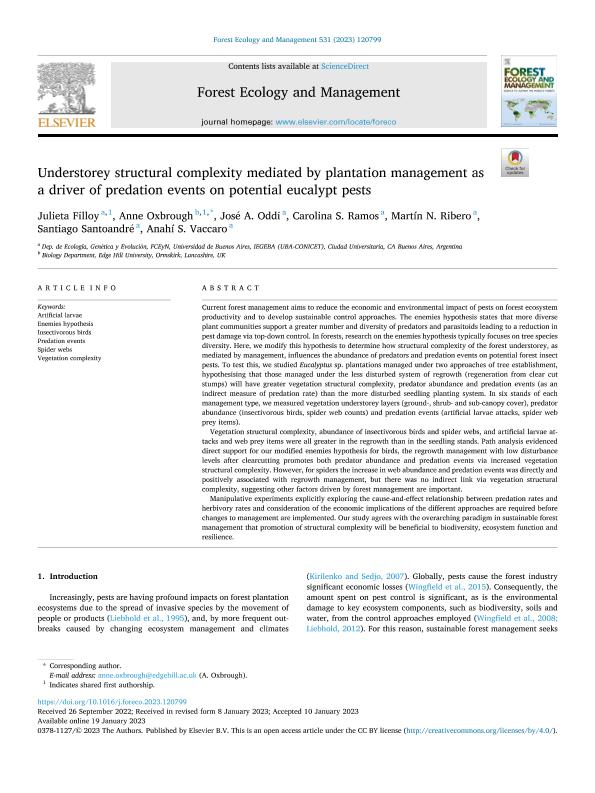Artículo
Understorey structural complexity mediated by plantation management as a driver of predation events on potential eucalypt pests
Filloy, Julieta ; Oxbrough, Anne; Oddi, José Alejandro
; Oxbrough, Anne; Oddi, José Alejandro ; Ramos, Carolina Samanta
; Ramos, Carolina Samanta ; Ribero, Martin Nicolas
; Ribero, Martin Nicolas ; Santoandre, Santiago
; Santoandre, Santiago ; Vaccaro, Anahí Sofía
; Vaccaro, Anahí Sofía
 ; Oxbrough, Anne; Oddi, José Alejandro
; Oxbrough, Anne; Oddi, José Alejandro ; Ramos, Carolina Samanta
; Ramos, Carolina Samanta ; Ribero, Martin Nicolas
; Ribero, Martin Nicolas ; Santoandre, Santiago
; Santoandre, Santiago ; Vaccaro, Anahí Sofía
; Vaccaro, Anahí Sofía
Fecha de publicación:
03/2023
Editorial:
Elsevier Science
Revista:
Forest Ecology and Management
ISSN:
0378-1127
Idioma:
Inglés
Tipo de recurso:
Artículo publicado
Clasificación temática:
Resumen
Current forest management aims to reduce the economic and environmental impact of pests on forest ecosystem productivity and to develop sustainable control approaches. The enemies hypothesis states that more diverse plant communities support a greater number and diversity of predators and parasitoids leading to a reduction in pest damage via top-down control. In forests, research on the enemies hypothesis typically focuses on tree species diversity. Here, we modify this hypothesis to determine how structural complexity of the forest understorey, as mediated by management, influences the abundance of predators and predation events on potential forest insect pests. To test this, we studied Eucalyptus sp. plantations managed under two approaches of tree establishment, hypothesising that those managed under the less disturbed system of regrowth (regeneration from clear cut stumps) will have greater vegetation structural complexity, predator abundance and predation events (as an indirect measure of predation rate) than the more disturbed seedling planting system. In six stands of each management type, we measured vegetation understorey layers (ground-, shrub- and sub-canopy cover), predator abundance (insectivorous birds, spider web counts) and predation events (artificial larvae attacks, spider web prey items). Vegetation structural complexity, abundance of insectivorous birds and spider webs, and artificial larvae attacks and web prey items were all greater in the regrowth than in the seedling stands. Path analysis evidenced direct support for our modified enemies hypothesis for birds, the regrowth management with low disturbance levels after clearcutting promotes both predator abundance and predation events via increased vegetation structural complexity. However, for spiders the increase in web abundance and predation events was directly and positively associated with regrowth management, but there was no indirect link via vegetation structural complexity, suggesting other factors driven by forest management are important. Manipulative experiments explicitly exploring the cause-and-effect relationship between predation rates and herbivory rates and consideration of the economic implications of the different approaches are required before changes to management are implemented. Our study agrees with the overarching paradigm in sustainable forest management that promotion of structural complexity will be beneficial to biodiversity, ecosystem function and resilience.
Archivos asociados
Licencia
Identificadores
Colecciones
Articulos(IEGEBA)
Articulos de INSTITUTO DE ECOLOGIA, GENETICA Y EVOLUCION DE BS. AS
Articulos de INSTITUTO DE ECOLOGIA, GENETICA Y EVOLUCION DE BS. AS
Citación
Filloy, Julieta; Oxbrough, Anne; Oddi, José Alejandro; Ramos, Carolina Samanta; Ribero, Martin Nicolas; et al.; Understorey structural complexity mediated by plantation management as a driver of predation events on potential eucalypt pests; Elsevier Science; Forest Ecology and Management; 531; 3-2023; 1-9
Compartir
Altmétricas



